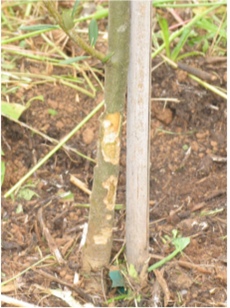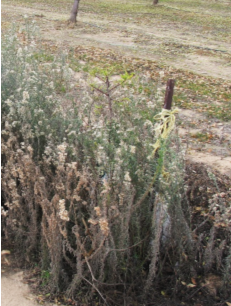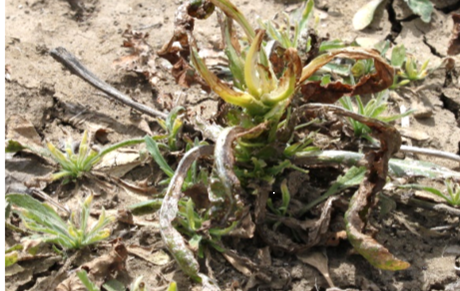KATHERINE JARVIS-SHEAN & BRAD HANSON
Weeds in young orchards compete with trees for orchard resources – sunlight, water and nutrients, setting back growth and yield. Weeds can also create cover for vertebrate pests which can then damage tree trunks (Figure 1) and irrigation systems. For these reasons, weed control is important for young orchards.
There are a number of challenges in weed management in young orchards. Young trees often are more susceptible to herbicide damage. A number of different annual grasses and broadleaves need to be controlled. There are fewer herbicides available for use in a young orchard, compared with mature trees. Several weed species are beginning to show resistance and/or tolerance towards herbicides that have previously been main-stays of weed management.
There are keys to effective weed control that are true no matter how old your trees. First, the weed problem must be correctly identified. UC Davis’s weed identification website is a useful tool for this step: weedid.wisc.edu/ca/weedid.php. Next, registered herbicide(s) with activity on your weed spectrum must be selected. Finally, the material must be applied properly, at the appropriate growth stage with well-calibrated equipment.
PRECAUTIONS WITH YOUNG ORCHARD WEED MANAGEMENT
Remember that tree crops are not resistant to herbicides. Crop safety is usually achieved by placement; we avoid injuring trees by placing herbicides below the foliage and green tissues but above the root zone. Knowing this, there are a few important things to keep in
mind:
Green trunk wood is often still susceptible to contact herbicides. Leave cartons on tree trunks for the first two years after planting or until the trunk diameter gets too large.
Branches on young trees are lower and more likely to get hit by drift. Be extra cautious with windy conditions, spray rig height, nozzle angles, and nozzle selection.
After planting, tree roots are shallow and soil is still settling, which means soil-applied herbicide can settle or run into loosely packed pockets or cracks. Make sure soil is settled before applying herbicides and manage water carefully to avoid moving herbicides too deeply into the soil.
OPTIONS FOR WEED CONTROL IN YOUNG ORCHARDS
Young orchards do have the advantage of starting from scratch. If perennial weeds such as bindweed are a big problem on a site to be planted with an orchard, take corrective action early. As much as possible, control weeds before planting, but be wary of residual action
of herbicides that might impact trees at planting. If you are planning on mounding the soil for tree rows, be sure that it does not closely follow herbicide application, to avoid concentrating herbicide-loaded topsoil in the mound. As much as possible, avoid mixing surface soil with herbicide into tree holes at planting. In an orchard replant situation, it
may be advisable to reduce rates or eliminate altogether the use of residual herbicides in the last season of the old orchard to minimize the risk for the new orchard.
There are a number of herbicides registered for use with nut trees two years old or younger. Reliable, long-term weed control depends on using herbicides with different modes of action in tank mix or in sequence and targeting different life stages. Pre-emergent herbicides are applied before weed seeds germinate and prevent weed
seedlings from establishing. Post-emergent herbicides work on weeds that have already germinated and emerged. However, these herbicides are most effective when weeds are small and young (Figure 3). There is no perfect rule of thumb for how small is small enough, but generally weeds should be less than 3 inches in height and diameter for
herbicides to be effective.
Table 1 shows a list of herbicides that, at last check, can be used on tree crop orchards. Always check the labels for any product you may consider using. Not all products are labeled on all tree crops, and this chart may become out-of-date. Label information can be found on websites such as Agrian (agrian.com/labelcenter/results.cfm) or CDMS
(cdms.net/Label-Database).
AVOIDING RESISTANCE
The key to avoiding or minimizing problems with herbicide-resistant weeds is varying your weed management approach. Many growers rely heavily on glyphosate because it is affordable and can provide good post-emergent weed control. However, by using the same
product and mode of action to kill weeds, we are selecting for herbicide resistance. To avoid this, add different modes of action or tank mixes to your herbicide program. Table 1 shows the mode of action for many different herbicides. By using herbicides with different modes of action within-season and from one season to the next, you attack weeds from
many different angles, making it hard for one resistance gene or one particular weed to thrive and build up a population.
| Herbicide | Example Trade Name | Site of Action | Notes | |
| Pre- emergent | EPTC | Eptam | N/8 | For well-established |
| pre emergent | Flumioxazin | Chateau | E/14 | 1 year needs carton |
| pre emergent | Indaziflam | Alion | L/29 | 1 year |
| pre emergent | Isoxaben | Trellis | L/21 | |
| pre emergent | Norflurazon | Solicam | F1/12 | 18 months |
| pre emergent | Oxyfluorfen | Goal | E/14 | |
| pre emergent | Pendimethalin | Prowl | Kl/3 | |
| pre emergent | Oryzalin | Surflan | Kl/3 | |
| pre emergent | Penoxsulam | PindaarGT | B/2 | 9 or 15 months |
| pre emergent | Rimsulfuron | Matrix | B/2 | Established 1 season |
| Post- emergent | Carfentrazone | Shark | E/14 | Not OK on green bark |
| pre emergent | Clethodium | Select | A/1 | Non-bearing only |
| pre emergent | 2, 4-D | Dri-Clean | O/4 | 1 year |
| pre emergent | Diquat | Diquat | D/22 | Non-bearing only |
| pre emergent | Fluazifop-p-butyl | Fusilade | A/1 | Non-bearing label in some crops |
| pre emergent | Glyphosate | RoundUp | G/9 | |
| pre emergent | Glufosinate | Rely 280 | H/10 | Not OK on green bark |
| pre emergent | Paraquat | E/14 | D/22 | Not OK on green bark |
| pre emergent | Pyraflufen | Venue | E/14 | Not OK on green bark |
| pre emergent | Saflufenacil | Treevix | E/14 | Not OK on green bark |
| pre emergent | Sethoxydim | Poast | A/1 |
ADDITIONAL RESOURCES:
UC Davis Weed Resource and Information Center
UC Weed Blog
UC Davis Weed Identification Tool
UC Herbicide Damage Symptoms ID Tool
Weed Section on crop-specific pages on UC IPM
“Orchard Floor Management” (Ch 28) in the Almond Production
Manual and “Vegetation Management” (Ch 26) in the Walnut
Production Manual: anrcatalog.ucanr.edu/Details.aspx?itemNo=3364





Leave a Reply